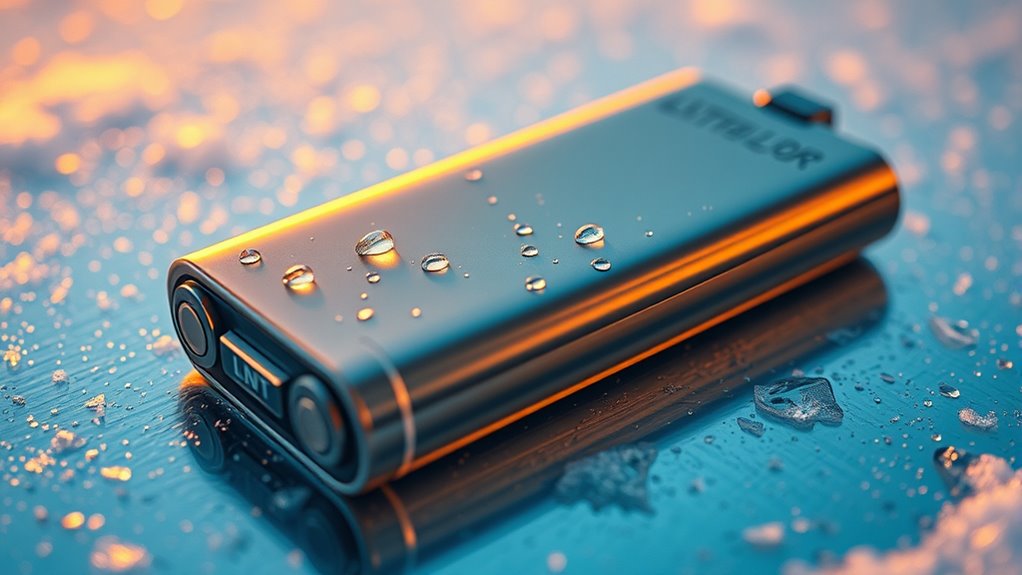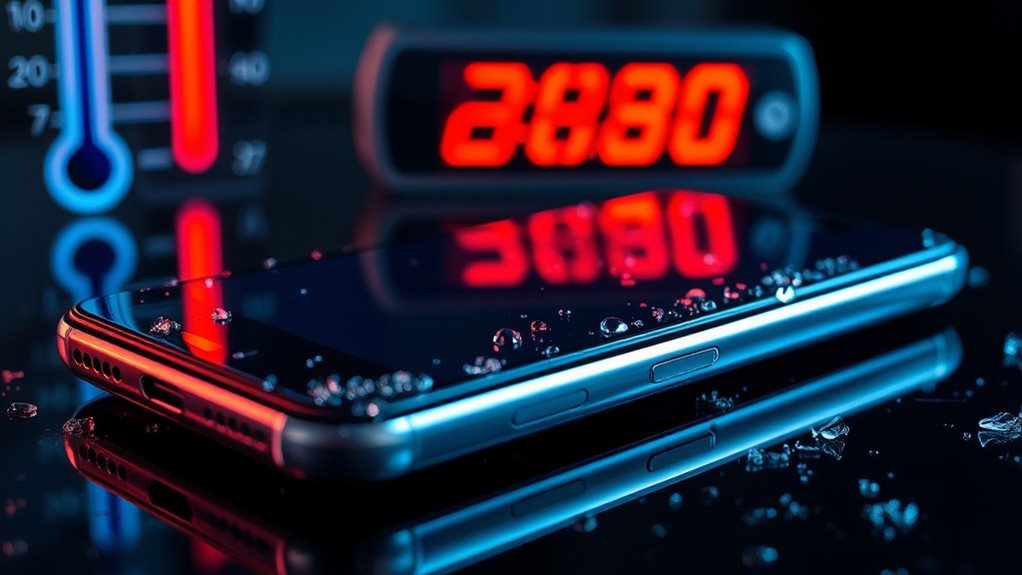Extreme temperatures impact your battery’s performance and lifespan. High temperatures speed up chemical reactions, causing faster capacity loss and degradation of components, which shortens your battery’s overall life. Cold temperatures slow down reactions, reducing power temporarily but not necessarily causing long-term damage. Managing heat with proper thermal strategies helps preserve your battery’s health over time. If you want to learn more about protecting your device from temperature effects, keep exploring further.
Key Takeaways
- High temperatures accelerate chemical reactions inside batteries, leading to capacity loss and faster degradation.
- Cold temperatures slow chemical reactions, reducing power output but generally causing less long-term damage.
- Repeated exposure to temperature extremes accelerates overall battery aging and reduces lifespan.
- Effective thermal management prevents overheating, preserving battery health and prolonging device lifespan.
- Maintaining optimal temperature conditions enhances battery performance and delays capacity decline over time.

Understanding how batteries perform and how long they last is essential for getting the most out of your devices. One of the key factors affecting battery performance is temperature. When temperatures are too high or too low, they can considerably impact your battery’s capacity and overall lifespan. To maintain ideal performance, you need to pay attention to thermal management, which involves controlling and regulating the temperature around your battery. Proper thermal management ensures your battery operates within the perfect temperature range, preserving its capacity and preventing premature degradation.
High temperatures are especially damaging because they accelerate chemical reactions inside the battery, leading to faster capacity loss. When your device gets overheated—say, from prolonged use or exposure to direct sunlight—the internal components, including the electrolyte and electrodes, degrade more quickly. This not only reduces the battery’s current capacity but also shortens its lifespan over time. Conversely, cold temperatures can temporarily reduce a battery’s ability to deliver power. When it’s cold, chemical reactions slow down, causing your device to drain faster or perform poorly until it warms up again. While cold doesn’t cause as much long-term damage as heat, repeated exposure can still harm your battery’s overall health.
High temperatures cause chemical reactions that accelerate capacity loss and reduce battery lifespan.
Maintaining good thermal management involves more than just avoiding extreme heat or cold. It’s about creating an environment where your battery can operate smoothly. For example, avoid leaving your phone in a hot car or exposing it to direct sunlight for extended periods. Using your device in well-ventilated areas helps dissipate heat more effectively. If you notice your device heating up during use or charging, consider removing any cases that trap heat or switching to a more efficient charger. Many modern devices incorporate thermal management systems, such as heat sinks or cooling fans, but these are not always enough if you subject your device to constant high temperatures. Additionally, tuning your device can help optimize thermal performance and extend battery lifespan.
In addition, the design of your device plays a role in thermal management. Manufacturers often include features like temperature sensors or cooling systems to prevent overheating. Properly managing heat not only preserves your battery’s capacity but also extends its lifespan by reducing the stress caused by thermal extremes. Ultimately, understanding how temperature affects your battery helps you make smarter choices—like avoiding overheating and keeping your device within recommended temperature ranges—so you can maximize its performance and longevity.
Frequently Asked Questions
How Does Temperature Impact Lithium-Ion Battery Chemistry?
You should know that temperature impacts lithium-ion battery chemistry considerably. When it’s too hot, it can cause electrolyte instability, increasing the risk of thermal runaway, which damages the battery or causes safety hazards. Cold temperatures slow down chemical reactions, reducing performance. Maintaining ideal temperature helps keep electrolyte stable and prevents dangerous conditions, extending your battery’s lifespan and ensuring safe, reliable operation.
What Is the Ideal Temperature Range for Storage?
You should store your battery between 32°F and 68°F (0°C to 20°C). This ideal temperature range minimizes the risk of thermal management issues and prevents damage from extreme heat or cold. Using proper battery insulation helps maintain a stable temperature, especially in fluctuating environments. Coincidentally, keeping your battery within this range extends its lifespan and preserves performance, making thermal management essential for long-term reliability.
Can Temperature Fluctuations Cause Battery Swelling?
Yes, temperature fluctuations can cause battery swelling due to thermal expansion. When batteries experience rapid temperature changes, the materials inside expand or contract unevenly, leading to swelling or bulging. This damage can compromise the battery’s integrity, increasing the risk of leaks or failure. To prevent this, avoid exposing your batteries to extreme or fluctuating temperatures, and store or use them within recommended temperature ranges.
How Does Cold Weather Affect Charging Efficiency?
Cold weather decreases your battery’s charging efficiency because low temperatures slow chemical reactions inside. When you experience cold charging, your device may take longer to charge or not reach full capacity. To counter this, try battery warming by keeping your device in a warmer environment before charging. Avoid cold charging in extreme cold, as it can strain the battery and reduce its lifespan over time.
Are There Temperature Thresholds That Cause Irreversible Damage?
Imagine a delicate dance where too much heat leads to a fiery misstep. Temperatures above 45°C can cause irreversible damage, risking thermal runaway and electrolyte evaporation. These thresholds weaken your battery’s structure permanently. If ignored, they may trigger dangerous conditions or shorten your battery’s lifespan. To safeguard your device, avoid exposing it to extreme heat, and keep it within recommended temperature ranges to ensure safety and longevity.
Conclusion
Understanding how temperature impacts your battery is like tending a delicate garden—you need to keep it in the right conditions to thrive. By avoiding extreme heat and cold, you prolong its performance and lifespan, ensuring your device stays reliable longer. Think of temperature as the weather for your battery’s growth; nurture it with care, and it’ll reward you with lasting power. Keep your battery cozy, and it’ll serve you well for years to come.










